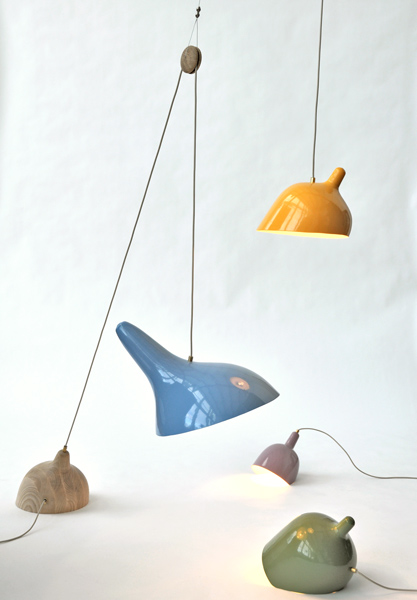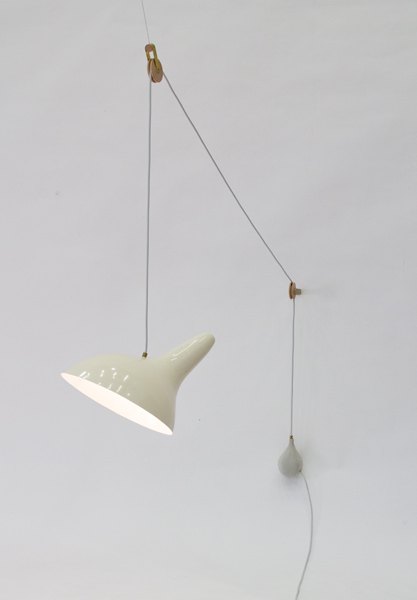Three years ago I was fortunate enough to come across the work of Swedish design collective DMOCH (David Ericsson, Marcus Berg and Ania Pauser) at Hive, a large open space at Ventura Lambrate that allows young designers and studios international exposure within a more alternative environment than is offered at the Salone del Mobile. That year had some very exciting work by studios and designers that I have subsequently followed such as the Rotterdam based duo, Studio WM, so it was with some anticipation that I recently remembered that I hadn't checked out DMOCH's new work for some time.
Regular exhibitors at the Stockholm Fair since 2009, DMOCH have also shown at Frankfurt Ambiente and in 2014 at Prague’s Designblok. I had always admired the versatility of their ‘Teresa’ lamp with its soft suede counterweight in complimentary colours and engaging pulley system for lowering and raising the lights into different positions. The idea of the light is to create an interaction between different levels in the room, allowing the lights to become a part of both the interior and the architecture. The lamp utilises two counterweights, two different shades and two pulleys, so it can be positioned together or apart, high or low.
The light was a natural extension of the 'Francis' light designed a year earlier that involved a similar shaped shade to 'Teresa' but which was sliced across one side to allow the lamp to work effectively as a floor lamp or as a wall light held by an extraordinarily organic looking timber wall hook that mirrored the shape of the shade itself.
As quirky and interesting as the 'Francis' lights were, the 'Teresa' design was a definite improvement, simplifying things to create an elegant light that still retained an element of whimsy.
It has to be said that it is David Ericsson’s recent solo work that is going from strength to strength both in his limited edition commissioned work for his Friends of Wood organisation and his production pieces for Italian manufacturer Piaval and Swedish company Gärsnäs. In recent years Gärsnäs have put some extremely interesting designs into production such as Lisa Hilland’s ‘My Granddaughter’s Cabinet’ and Fredrik Färg and Emma Marga Blanche’s ‘Emma’ and ‘Emily’ armchairs. This year at the Stockholm Fair the company launched Ericsson’s ‘Madonna’ chair – a minimal design in natural beech with a seat and back in either fine plywood or in thick vegetable tanned leather.
In my view, the ‘Madonna’ chair (either with or without arms) is one of the most beautiful to be launched since Jasper Morrison’s ‘Lightwood’ chair for Maruni in 2011. Scrolling through hundreds of images of new products launched at this year's Stockholm Fair, the purity of the chair's form captured me instantly. The plywood component does have an element of Barber Osgerby’s never released plywood ‘Shell’ chair for Isokon Plus but the frame is rooted in the history of European farm chair designs not in the lightweight all-ply solutions developed for Isokon by Marcel Breuer in the 1930's. Ericsson’s ‘Madonna’ chair uses conventional turned timber legs and crossbraces with the plywood forming a tension cap across the seat and back. Sturdy but still fairly lightweight it retains a beautiful visual fineness. In leather the look is slightly different as the rougher reverse side of the hide is visible on the chair’s back and so has a strong link to classic Danish designs such as Børge Mogenson’s ‘Hunting’ and ‘Spanish’ chairs from the 1950’s.
"We need to focus on the zeitgeist to be able to develop good and interesting products - products that not only fit the market for a short period of time, but that remain and evolve over time to fit the new needs of our environment."
David Ericsson
In 2013 Ericsson founded Friends of Wood – an organisation established to discover more about wood and promote its biodiversity. The organisation also organise workshops, lectures and projects that promote the sustainable use of timber in design. He was invited to participate in the exhibition “Hans Wegner A Nordic Design Icon from Tønder” at The Tønder Art Museum to celebrate the 100th anniversary of the Danish master. In addition to the work of Wegner it featured designs from one designer from each of the Nordic countries. Ericsson designed a collection that bears the name of Hans J. Wegener’s hometown, Tønder and consists of a cabinet, a sideboard, desk and chair combining birch, copper fabric and Aquarelle paper.
The most immediately impressive piece is the ‘Whale’ cabinet with its interesting timber construction and whimsical illustrated façade but the entire collection warrants close inspection for the beautiful joinery details and largely minimalist concepts. Early versions of the 'Madonna' chair were part of the selection as well as a version of a desk from his 'Carl Malmsten Made Me Do It' graduating project.
Ericsson graduated from the Carl Malmsten Woodworking School in 2010 and it shows in the quality of his work. His graduating project called ‘Carl Malmsten Made Me Do It’ featured a floor lamp several table lamps, a wall cabinet and a desk and chair - all made from timber and leather. The collection is beautifully simple and with a timeless Scandinavian quality but the work also expresses a playfulness around construction details and moving parts.
Beyond his work in furniture, Ericsson is also a guest teacher at Carl Malmsten Furniture Studies. For more on Ericsson's work go to either his studio website here, or the Friends of Wood site here.



















